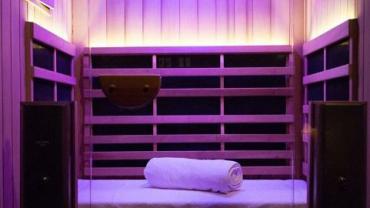
Have you ever walked into a bright yellow room and immediately felt a sense of warmth and cheer or perhaps you felt like the light blue walls of the hospital room made the temperature seem uncomfortably cool? Why is it that we automatically associate red and green with the holiday season or shades of brown and orange with fall? Subconsciously we are aware that color prompts memories images and feelings. We associate plant life with green cool water with blue warm sunshine with yellow and romance with red. Many institutions (including doctor’s offices and hospitals) have sought to utilize color therapy when remodeling as a means of encouraging feelings of comfort and peace. Although a very ancient science with little research to validate its effectiveness we are starting to see a renewed interest in chromotherapy for both stress reduction and healing.
In its most literal sense chromotherapy is “a method of treatment that uses the visible spectrum (colors) of electromagnetic radiation to cure diseases.” Light is energy and each color possesses a unique wavelength frequency and quantity of energy. According to the principles of chromotherapy optimal wellness is created within the context of a harmonious relationship between the electromagnetic fields of the universe and those of the human body. Consequentially if the frequency and energy fields of cells or organs deviates from normal and becomes disharmonized with the environment disease and malfunction are more likely to arise. The energy generated by specific colors is viewed as an activator of biochemical and hormonal processes that restore balanced energy fields and healing.
Chromotherapy is based on the foundational principles of physics and was applied to medicine by both Newton and Einstein. Even before the birth of our modern sciences ancient Greeks and Egyptians used colored rooms for healing and the 6th century BC Ayurvedic physician Charaka used sunlight to treat diseases. More modern physicians Pleasanton (1876) and Hassan (1999) routinely used blue light to promote healing of injuries burns and aches. A 19th century physician Edwin Babbitt is famous for his writings on the principles of chromotherapy and their practical applications in medicine. Known as the pioneer of modern chromotherapy he promoted the use of specific colors for a myriad of health conditions including rheumatism sciatica and headaches. For example he used red color as a circulatory stimulant yellow and orange as nerve stimulants and blue for soothing and its anti-inflammatory properties. Babbitt’s contemporary Ghadiali (1927) is credited with the first published book that turned the theory of chromotherapy into a legitimate field of healing using scientific principles and modern experimentation to prove that the unique energy possessed by every color has a specific action upon different organs and body systems and can act to sedate or stimulate the function of that organ or body system. Ghadiali’s work has been continued by Takkata (1951) and Ott (1987) and even taken into the realms of psychology by Gerard (1970).
In Russia chromotherapy is used as part of a relatively new system of medical assessment and treatment. Known as virtual scanning color cognition is used to assess the health of 30 organs and determine the presence of pathological dysfunction in those organs. The scanner is based on the principle that organs transmit neurological signals (with specific frequencies) to the brain regarding the state of their health and in the presence of pathology the transmitted neural signals possess different frequencies. These changes in neural signals can be identified through the use of color frequencies known as color cognition. At the same time the brain can prefer color frequencies which would “correct” the neural signal from diseased organs. Therefore therapeutic colors are also identified and used for healing. As radical as this system may appear the case studies presented have been remarkable.
Today chromotherapy is employed for balancing various neurohormonal imbalances which contribute to common psychiatric disorders. Light frequencies have been shown to affect serotonin and melatonin pathways which influence the circadian rhythm and either promote or hinder health and healing. Seasonal affective disorder (SAD) depression sleep disorders and PTSD are commonly associated with disrupted circadian rhythms and have been shown to be good candidates for chromotherapy by seeking to rebalance key neurohormones using color frequencies that would enhance serotonin and melatonin production.
Other studies have shown chromotherapy successfully utilized in the treatment of acute respiratory diseases chronic tonsillitis cervical dorsopathies vegetative dysfunction hypertension and macular degeneration. Diabetes was improved through the use of chromotherapy in a study that revealed improved activity of the enzymes glucose oxidase cholesterol esterase plus cholesterol oxidase and lipase after exposure to purple and dark purple light. This study concluded that specific color frequencies were able to either catalyze or reduce enzymatic reactions thereby influencing biochemical reactions (such as the oxidation of glucose) which could be of great benefit in the management of certain health conditions (such as diabetes).
Russia and the UK remain the leaders in the therapeutic use of chromotherapy and the limited number of published studies are primarily rooted in their efforts. However chromotherapy presents an extremely safe and potentially effective treatment modality for many common psychiatric conditions seen in the western cultures. Considering its use as an adjunct treatment for depression stress management headaches and general healing is valuable in light of the fact that an increasing number of patients are seeking more natural alternatives to these prevalent conditions. Hopefully further studies will validate the efficacy of alternative treatment options such as chromotherapy.